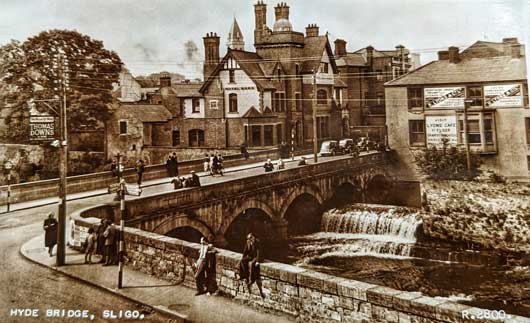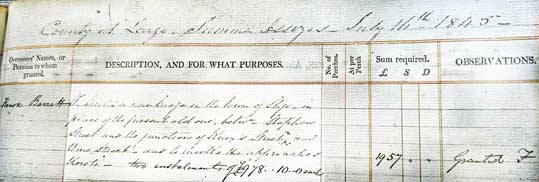BRIDGING THE DISTANCE— Intergenerational Administration in Sligo
Published in Issue 5 (September/October 2022), Volume 30By Corinne Herward
Sligo’s archive holds many records that chart the evolution of governance in the county both before and after independence. One of the most important administrative duties in a county with a mountainous and riverine landscape is the construction and maintenance of bridges. Although no formal survey has been undertaken in Sligo, the National Inventory of Architectural Heritage (NIAH) lists at least 49 protected structures traversing these waterways, connecting regions that would otherwise be remote and inaccessible. The creation and evolution of these bridges charts the history of governance from the earliest days of settlement to modern-day Sligo. Sligo County Archive holds some of the Grand Jury presentment books that were not destroyed in the Four Courts blaze of 1922, as well as holding the Sligo Corporation minute books and originals of newspapers such as the Sligo Champion and the Sligo Independent, which chart the development of infrastructure in the county.
Bridges are one of the few historical monuments that are still used for their original purpose. As a focal point of settlement, transport and commerce, modern bridges are often based on the site of older bridges that have been improved or replaced over time. Many of these structures pre-date the administrative records in our collection, and we rely on private accounts for reports of their provenance. Hyde Bridge, located between Stephen Street and Lower Knox Street in the heart of Sligo town, is an example of such a structure. This Victorian monument is also the site of the earliest reference to a bridge in Sligo town, recorded in the Annals of the Four Masters, which mention the burning of Sligo bridge in 1188. The bridge was rebuilt and improved upon by Cathal Óg O’Connor, then king of Connaught, in the fourteenth century. The evolution of the bridges in Sligo serves as a reminder that only part of Sligo’s urban development is represented in our records.

Above: Hyde Bridge, the site of two older bridges dating from the twelfth and fourteenth centuries. (Sligo County Archive)
The shiring of Ireland was completed in the early seventeenth century following the Elizabethan wars of reconquest, solidifying English control in Ireland. Grand Juries were created to administer regional government, and their duties evolved and expanded over time. They were composed of twenty-three male landowners, Protestant by law from 1707–1793, and by convention for many years afterwards. Sligo holds a collection of presentment books representing sessions ranging from 1809-1899. These presentment books record the decisions of the Grand Jury on how to spend local taxes. The presentment books of Sligo describe hundreds of road and bridge repairs as well as the different staff members kept on the books.

Above: ‘County of Sligo, Summer Assizes July 16th 1845’—‘to build a bridge [Victoria, later Hyde] in the town of Sligo, in place of the present old one, between Stephen Street and the junction of Knox Street and Wine Street and to make the approached thereto two instalments of £978 10[s] each.’ The presentment was approved by Col. Knox Barrett, son of William Barrett, former high sheriff of Sligo. (Sligo County Archive)
The construction of Victoria Bridge, formally commenced on 1 May 1846, but the bridge did not open to the public until 26 June 1852. There are some discrepancies between the government and private accounts of this period in Sligo records. While the initial cost of the bridge was estimated at £1,957, Woodmartin suggests that the costs may have risen to £4,243, or an estimated modern value of €450,724, which included the demolition of the old bridge and the compensation of the owners of nine houses built on or beside the bridge. The bridge continues to reflect the changing landscape of Sligo, as it was renamed in December 1943 to reflect the new political culture in Ireland. The Sligo Champion describes how the Sligo branch of the Gaelic League proposed that the Corporation rename Albert Road to Pearse Road, Victoria Line as Markievicz Road, and Victoria Bridge was renamed Hyde Bridge, celebrating Douglas Hyde, the first president of Ireland. This alteration may seem anachronistic to its construction, but when we consider the older bridge that once stood in its place, we can understand the retitling as a continuation in the history of the town.
New records which will eventually become part of our archive are created by the County Council every year. New Bridge, or Markievicz Bridge as it is also known, is a narrow seven-arch bridge dating from 1670. The bridge holds two lanes of traffic and a footpath along one side. However, the lack of footpath on the left-hand side of the road prompted Sligo County Council to commission a feasibility study for a pedestrian bridge in 2007. The slender glass suspension bridge, modelled on the success of a similar structure in Carrick-on-Shannon, would stand independently, and co-exist with the 350-year-old structure, while improving its functionality. Although this footbridge was never constructed, the feasibility study produced by the council and the associated records produced during the project are an example of the county’s evolution and the changes that will build on our archives for many years to come.
Corinne Herward is an archivist with Sligo County Council.
















